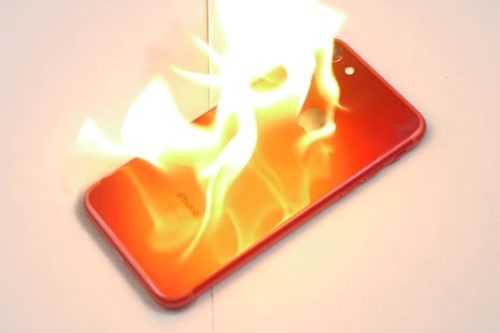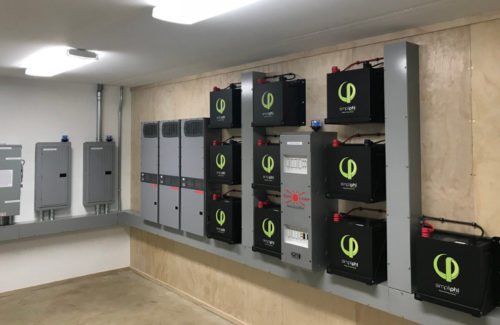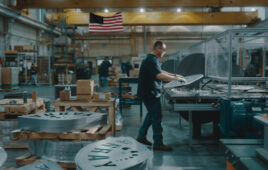When it comes to lithium-ion batteries, reports of spontaneous fires in phones, hoverboards, cars and laptops have become all too common. The same risks of thermal runaway and fire danger exist when it comes to residential and commercial energy storage installations. But not all lithium-ion batteries pose a fire danger.
 There are actually a number of different battery chemistries that make up the “lithium-ion” (Li) category — each with its own chemical composition and properties:
There are actually a number of different battery chemistries that make up the “lithium-ion” (Li) category — each with its own chemical composition and properties:
- LCO – Lithium Cobalt Oxide
- NMC – Lithium Nickel Manganese Cobalt Oxide
- LMO – Lithium Manganese Oxide
- NCA – Lithium Nickel Cobalt Aluminum Oxide
- LFP – Lithium Iron Phosphate
Lithium itself does not present a danger of thermal runaway or fire. Instead, it’s cobalt that is hazardous.
Lithium Cobalt Oxide (LCO) is commonly used in cell phones, laptops and digital cameras, and Lithium Manganese Cobalt (LMC or LCM) is used in most electric cars. Both are known to break down at much lower temperatures and release far more potentially hazardous energy than other Li compounds.
What’s more, cobalt-based Li batteries actually create heat as part of their normal operation. That means they create exponentially greater risk of thermal runaway than if they didn’t create any heat at all. Using cobalt is a little like putting lighter fluid on your charcoal, and then throwing a match on it.
To make matters worse, there is no effective fire retardant against a cobalt fire. When a cobalt fire starts, it is toxic, and the only response is to let it burn itself out.
Li battery makers that include cobalt and manganese have taken steps to mitigate fire danger by using cooling and ventilation systems. While such systems may help reduce the risks, they don’t eliminate them.

SimpliPhi lithium iron phosphate (LFP) batteries were used in a solar installation on California Gov. Jerry Brown’s off-grid private residence
By contrast, Lithium Iron Phosphate (also known as Lithium Ferrous Phosphate) generates very little heat and does not pose a risk of thermal runaway or fire — and therefore doesn’t require ventilation or cooling.
When it comes to lithium-ion safety, toxicity is also a concern. As with fire, it’s not lithium but cobalt that presents toxic risk at every point along the product pipeline — from the moment the element is extracted from the earth until the time the battery is thrown away or recycled.
For cobalt miners — including the young children who are often forced into the practice — exposure to the toxic metal is known to cause breathing problems and birth defects. Factory workers are also at risk, as, according to the CDC, chronic exposure to cobalt-containing hard metal (dust or fumes) can result in a serious lung disease called “hard metal lung disease” and inhalation of cobalt particles can cause respiratory sensitization, asthma, shortness of breath and decreased pulmonary function.
When it comes to disposal, there is also a risk that the batteries will release toxic gases if damaged, endangering both sanitation workers and communities.
LFP is the only lithium-ion chemistry that does not contaminate the environment or pose any hazard to living organisms.
So how should fire danger and toxicity play into the decision making process for installers?
- For installations in hot climates, LFP has an even greater advantage over heat-producing cobalt chemistries.
- Because LFP batteries require no ventilation or cooling equipment, they can be installed in much tighter spaces.
- In hospitals, food service businesses and any home or business where the primary decision making driver is safety, LFP offers an environmentally benign, non-toxic chemistry with no risk of fire.
- In looking at total cost of ownership, an LFP system that does not require ventilation, cooling or thermal monitoring equipment is often the most cost effective solution.
- For installations in areas prone to wildfires, cobalt-based batteries ignited by fire create toxic “superfund” sites in the homes and businesses where they are installed. LFP does not.




Loving my VMAX LFP Lithium Iron battery 🙂
Can you recap what tech is used by each of the main residential battery vendors eg Tesla, LGChem, Sonen?
All three brands use lithium, but we’ve only been able to confirm that Sonnen uses lithium ferrous phosphate (LFP), like what is explained in this article. We’ll work on confirming the rest.
can you recommend a supplier in Canada Toronto (GTA) they would be for electric bikes
We are the supplier fro this applications, electric bilkes, feel free email me vivi@hpkbattery.com
That’s a West Coast Sustainables project right there ! http://www.westcoastsustainables.com
That looks awesome.
Yes LFP is one of the safest chemistries. But if money is not a concern I would go with LTO. All batteries generate heat when charging, and probably not much difference between them. There’s no escaping the laws of thermodynamics. LFP has lower power and energy density, which helps its safety rating. But if you add more battery racks to get the same performance, you’re also increasing the risk of energy density. There are always trade offs. In my experience, it is a matter of the application and the budget. In installing over 80 battery plants, I’ve seen failures and fires only with lead acid and never a li-Ion actually catching fire in the field.